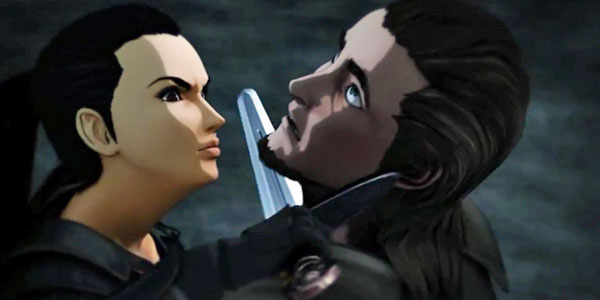Sometime during the development of Dragon Age II, the team apparently decided that by far the most interesting part of the expansive fantasy world they’d created was the conflict between mages and templars. It became the central theme of the second game, while most of its tie-in content points to an even stronger focus in the not-yet-officially-announced Dragon Age III. This would have been fine, except they don’t seem to have a clear idea of what to do with this idea.
That’s the central problem with Dragon Age: Dawn of the Seeker, the full-length animated film that the team produced with FUNimation Entertainment. The movie looks great, and it’s a fine way to waste 90 minutes, but it also highlights the franchise’s unfortunate tendency to take an interesting idea and run it into the ground for lack of a new story to tell.
As a standalone movie, Dawn of the Seeker is visually impressive, but it tells a story too formulaic to be especially interesting. Cassandra, our heroine, is a badass mage hunter who hates mages because they killed her family, which makes it awkward when she has to team up with a mage to uncover some conspiracy to use an elf girl to control dragons or something. After spending the whole movie on the run from the law, they need to learn the power of friendship and teamwork and save the church in a giant battle with the dragons.
For someone who’s familiar with the franchise, Dawn of the Seeker is visually impressive but tells a story too formulaic to be especially interesting. We learn the backstory of Cassandra, who existed mainly as a narrative device in Dragon Age II, and get our first look at Orlais and the Chantry, but it’s all so superficial that it doesn’t tell us much. Especially since most of the key players are dead by the end of the film.
The movie has a fair amount in common with the year’s other major Dragon Age tie-in, David Gaider’s novel Dragon Age: Asunder. But while Gaider, the lead writer of the franchise, loaded the novel with new ideas that could have a major impact on the world (though they don’t really matter within the novel) and momentous events (that get put off way too long and then end up feeling redundant), the movie seems to have been designed not to matter much, telling a self-contained story that resolves itself without any particular impact on the wider world.
But what really ties the two together is that neither seems to have anything new to say about the conflict at the heart of both stories. We’ve known the basic premise of the mage-Templar dispute, and most of the ethical issues, since Dragon Age: Origins, but we seem to have entered this fascinating space where the video games are doing a better job of deepening the story than a film or even a book.
The frustrating thing about Dragon Age II, where the drama was most fully realized, came at the end of the game’s third act when you realized that all the moral dilemmas your character had faced were funneling into a single binary choice — one that, as it happens, doesn’t even make much difference in the end. Asunder essentially recreates the same scenario, built around a character with even less control over the situation, whereas Dawn of the Seeker sidesteps the dispute entirely, featuring a story about corrupt church officials teaming up with renegade mages in a blind quest for power.
What’s depressing about this is that the Dragon Age franchise has created one of the deeper, more creatively realized and coherent modern fantasy worlds out there, one with no shortage of potential stories to tell. Building every new story around a single big theme just seems to cheapen it — especially when they don’t have anything in particular to say.
